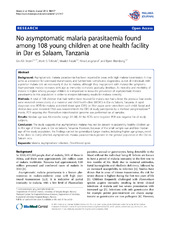| dc.contributor.author | Strøm, Gro Elizabeth Ann | en_US |
| dc.contributor.author | Tellevik, Marit Gjerde | en_US |
| dc.contributor.author | Fataki, Maulidi | en_US |
| dc.contributor.author | Langeland, Nina | en_US |
| dc.contributor.author | Blomberg, Bjørn | en_US |
| dc.date.accessioned | 2014-05-14T09:16:05Z | |
| dc.date.available | 2014-05-14T09:16:05Z | |
| dc.date.issued | 2013-11-14 | eng |
| dc.identifier.issn | 1475-2875 | |
| dc.identifier.uri | https://hdl.handle.net/1956/7927 | |
| dc.description.abstract | Background: Asymptomatic malaria parasitaemia has been reported in areas with high malaria transmission. It may serve as a reservoir for continued transmission, and furthermore complicates diagnostics, as not all individuals with a positive malaria test are necessarily ill due to malaria, although they may present with malaria-like symptoms. Asymptomatic malaria increases with age as immunity to malaria gradually develops. As mortality and morbidity of malaria is higher among younger children it is important to know the prevalence of asymptomatic malaria parasitaemia in this population in order to interpret laboratory results for malaria correctly. Methods: A total of 108 children that had neither been treated for malaria nor had a fever the previous four weeks were recruited consecutively at a maternal and child health clinic (MCHC) in Dar es Salaam, Tanzania. A rapid diagnostic test (RDT) for malaria and dried blood spot (DBS) on filter paper were taken from each child. Social and clinical data were recorded. DNA was extracted from the DBS of study participants by a method using InstaGene™ matrix. PCR targeting the Plasmodium mitochondrial genome was performed on all samples. Results: Median age was 4.6 months (range 0.5-38). All the RDTs were negative. PCR was negative for all study subjects. Conclusion: The study suggests that asymptomatic malaria may not be present in apparently healthy children up to the age of three years in Dar es Salaam, Tanzania. However, because of the small sample size and low median age of the study population, the findings cannot be generalized. Larger studies, including higher age groups, need to be done to clarify whether asymptomatic malaria parasitaemia is present in the general population in the Dar es Salaam area. | en_US |
| dc.language.iso | eng | eng |
| dc.publisher | BioMed Central | eng |
| dc.relation.ispartof | <a href="http://hdl.handle.net/1956/7929" target="blank">Diagnosing pediatric malaria in Dar es Salaam, Tanzania. Clinical and laboratorial perspectives</a> | eng |
| dc.rights | Attribution CC BY | eng |
| dc.rights.uri | http://creativecommons.org/licenses/by/2.0/ | eng |
| dc.subject | Malaria | eng |
| dc.subject | Asymptomatic infection | eng |
| dc.subject | Dried blood spots | eng |
| dc.title | No asymptomatic malaria parasitaemia found among 108 young children at one health facility in Dar es Salaam, Tanzania | en_US |
| dc.type | Peer reviewed | |
| dc.type | Journal article | |
| dc.date.updated | 2013-11-16T20:03:11Z | |
| dc.description.version | publishedVersion | en_US |
| dc.rights.holder | Copyright 2013 Strøm et al.; licensee BioMed Central Ltd. | |
| dc.rights.holder | Gro EA Strøm et al.; licensee BioMed Central Ltd. | |
| dc.source.articlenumber | 417 | |
| dc.identifier.doi | https://doi.org/10.1186/1475-2875-12-417 | |
| dc.identifier.cristin | 1109732 | |
| dc.source.journal | Malaria Journal | |
| dc.source.40 | 12 | |

